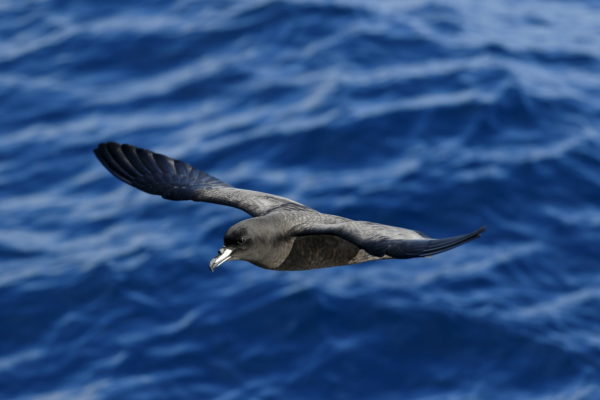When it comes to predation risks, it helps if you’re big and have attitude – especially if your breeding colony is on the mainland. Westland Petrels are both big and feisty and appear to be able to cope with some of our more common introduced villains. But that doesn’t necessarily mean they’re not at risk.

The Westland Petrel is the largest burrowing petrel that still nests on mainland New Zealand, with its only breeding habitat, just south of Punakaiki. The birds nest within a kilometre of the main highway and yet, until very recently, little was known about their natural history.
Dr Susan Waugh of the Museum of New Zealand Te Papa Tongarewa and Kerry-Jayne Wilson from the West Coast Penguin Trust investigate threats to the petrels in a paper published in Marine Ornithology and identify some key predation risks as well as other threats to the population’s long-term survival. Their research reveals we may be underestimating the risk status of the birds. Is it time for a Threat Classification upgrade?
“Predatory introduced mammals sighted in and around the colonies during 2010–2016 include brushtail possums, stoats, and rats, but breeding success (ca. 65% of eggs laid fledge chicks) suggest that their presence may not hinder breeding success at Study Colony. The effects of these predators and browsers at smaller colonies are unquantified.”
While possums don’t appear to affect breeding birds directly, possum and goat browse is likely to be more of an issue, the researchers believe.
“…important but low-severity threats that are likely to affect the entire population (therefore having high scope) include browsing by introduced goats and brushtail possums, which reduces plant cover and increases erosion potential. Goat trampling creates holes in burrows and can increase access to nestlings for the native, but predatory, weka (Gallirallus australis).”
Far worse than the erosion caused by goats, however, can be weather events such as tropical storm ‘Ita’.
“The Westland Petrel nests on steep, densely forested hills of 20–250 m altitude. Burrows are usually concentrated in areas where the ground is relatively open, with adjacent take-off areas. The breeding habitat was severely affected by tropical storm Ita in 2014, leading to the damage or destruction of up to half the area of those colonies inspected, together containing up to 75% of the breeding population.”
The damage from that one storm continues to have an impact on the birds three years later.

“The impact on breeding frequency for affected birds is likely to be substantial, with up to 50% of the area of at least three major colonies affected by severe erosion (in which all substrate was removed), or by uprooted trees destroying or reducing access to burrows. From our observations to 2017, many of these areas remain inaccessible to the petrels, as the resulting massive volumes of tree trunks and rotting vegetation completely obstruct the bird’s access to the soil, and upturned tree-root systems have removed all substrate in areas. This environment also provides a hazardous landscape in which to land or move about for the petrels.”
What’s more, the storm damage has removed canopy trees and exposed colony sites to further erosion risks through heavy rain events – and heavy rain is something of a feature of the South Island’s West Coast.
“As most canopy trees were removed from the two monitored colonies, future heavy rainfall events, common in this region with over 2 m rainfall per year, are causing further soil erosion, which threatens a significant proportion of remaining burrows. During the 2014 storm, over 200 mm of rain fell in 24 h, but this is not an uncommon event in this region.”
As the authors explain, even the toppling of one canopy tree causes extensive damage.
“The lowland podocarp forest present in the colonies is composed of canopy trees of around 15 species, each of which can measure 20–60 m in height and 1–4 m in diameter; each tree in this temperate rain forest could almost be called an ecosystem, with many hanging vines and epiphytes. The volume of the tree, its foliage, branches and root system, once toppled, is huge. In the affected colonies we have visited, very large volumes of plant material and soil are disturbed and unable to be used by nesting petrels.”
While we can’t solve the West Coast’s weather issues, the biggest threats to West Coast Petrels are things we can do something about: pigs and dogs.
“Predation by pigs and dogs remains a potentially high-risk threat because of the proximity of these two invasive species to the petrels’ nesting habitat. Vagrant dogs have killed petrels at the colonies in the past, and pigs have been liberated nearby by people seeking to establish a pig population for hunting. Dogs killed all Little Penguins (Eudyptula minor) monitored at a small colony 2.5 km from Study Colony in 2016. In 2016, there was an established population of feral pigs within 20 km. Either of these predators has the potential to extirpate entire colonies and should be considered a major threat to the petrel population. Pig invasion is considered more severe than dog predation, as pigs are likely to be more pervasive, more persistent, and harder to eradicate than vagrant dogs. These threats remain the most pervasive and potentially destructive that we have documented.”
Overall, the authors believe these big, feisty birds are actually more at risk than we realise.
“The latest review of the threat status of Westland Petrels undertaken in 2016 (IUCN 2017) reused information from the 2012 assessment, without incorporating more recent information, and listed the threat status as Vulnerable. Based on our assessment of a revised area of occupancy (0.16 km2) and significant ongoing degradation of habitat, we submit that a revision of the threat status from Vulnerable to Endangered is warranted.”

